USSR ballistic missiles
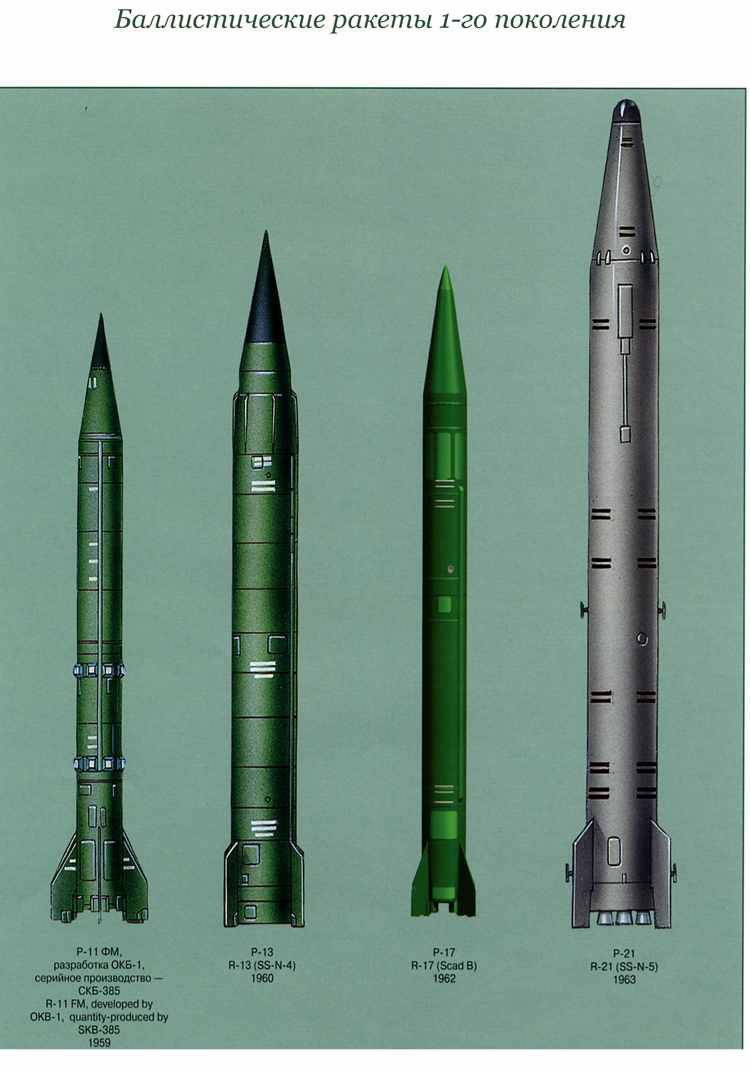
The main designer of this BR was S.P.Korolyov.
When developing a marine modification of the BR P-11FM a whole complex of complex problems associated with a liquid jet engine (LRE) was solved. In particular, the storage of refueling tanks in the mine of a submarine was ensured (the P-11 rocket was refueled before firing). This was achieved by replacing alcohol and liquid oxygen, which, after refueling, required constant drainage and, accordingly, recharge, for kerosene and nitric acid, which could be stored in sealed tanks of the rocket for a long time. Finally, it was ensured and its launch in the conditions of rolling the ship. However, shooting was possible only from a surface position. Although the first successful launch was made on September 16 1955 of the year, it was adopted only in the 1959 year. The BR had a range of only 150 km with a circular probable deviation (QUO) of about 8 km, which allowed it to be used only for shooting at large area targets. In other words, the combat value of these first BRs was small (the firing range was almost 2 times less than that of the BR (A4) (“V-2”) obr. 1944 of the year, with almost the same QUO).
Next BR P-13 was created specifically for the submarine from the very beginning. Initially, work on this BR was headed by S.P. Korolyov, and then V.P.Makeev, who became the permanent chief designer of all subsequent marine BR Navy of the USSR.
With the mass increased by almost 2.5 times, compared to the P-11FM, the sizes of the P-13 BR increased by only 25%, which was achieved by increasing the density of the missile layout.
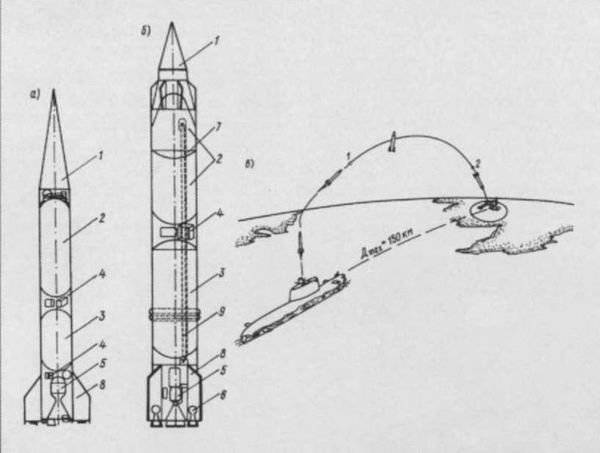
The first ballistic missiles with surface launch:
a - P-11FM;
b - P-13 1 - the head part; 2 - oxidizer tank; 3 - fuel tank; 4 - (control equipment; 5 - central chamber; 6 - steering chambers; 7 - separator bottom of the oxidizer tank; 8 - missile stabilizers; 9 - cable shaft;
в - flight path of the Р-11ФМ 1 rocket - the end of the active segment; 2 - the beginning of stabilization in the dense layers of the atmosphere
The firing range increased at the same time more than 4 times. Improved shooting accuracy was achieved by separating the head section at the end of the active leg of the flight. In 1961, this BR was adopted for service.
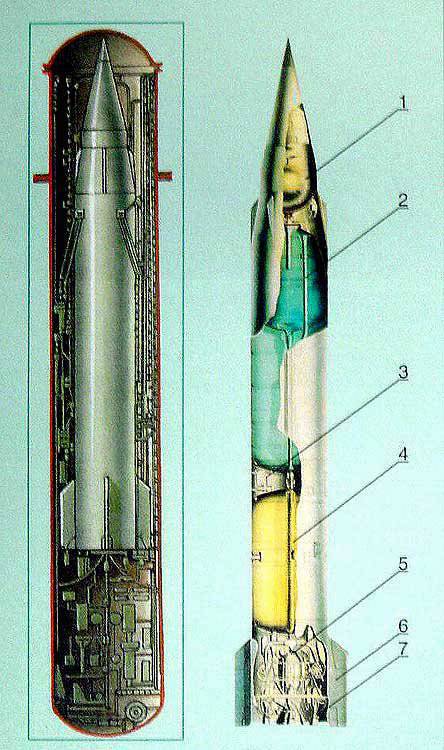
The R-13 rocket was a single-stage ballistic missile with a single-piece detachable head. The head part and tail section of the rocket were equipped with four stabilizers. 1 head; 2 oxidizer tank; 3 control equipment; 4 fuel tank; 5 central combustion chamber LRE; 6 rocket stabilizer; 7 steering cameras
But it could also start only from a surface position, therefore, in fact, this BR was outdated at the time of its adoption (as early as 1960, the United States adopted Polaris A1 ("Polaris A1") with solid propellant jet engine (RDTT), underwater launch and a greater range of fire).
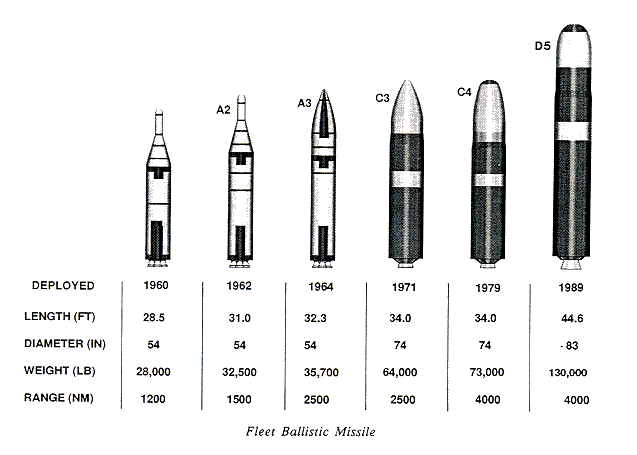
The development of American naval ballistic missiles
Work on the first domestic BR with underwater start P-21 started in 1959 year. A “wet” start was adopted for it, that is, a start from a mine filled with water. In the United States, a dry start was adopted for marine BRs, that is, a start from a mine in which there was no water at the time of launch (the mine was separated from the water by a ruptured membrane). In order to ensure a normal start from a mine filled with water, a special mode of LRE exit to the maximum thrust was developed. In general, it was thanks to the LRE that the problem of the underwater launch was decided in the USSR easier than in the USA with a solid-fuel engine (adjusting the thrust of this engine then caused considerable difficulties). The firing range was again increased almost 2 times with the next improvement in accuracy. The rocket was put into service in 1963 year.
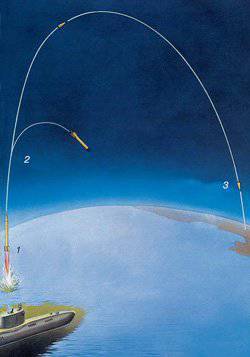
P-21 rocket flight path:
1 - start; 2 - head compartment; 3 - the entrance of the head of the atmosphere
However, this data was twice as bad as the next US BR - “Polaris A2 ', which was put into service in the 1962 year. Moreover, the Polaris A-3 (“ Polaris A3 ”) was already on the way in the US with a range of 4 600 km (adopted by 1964 year).
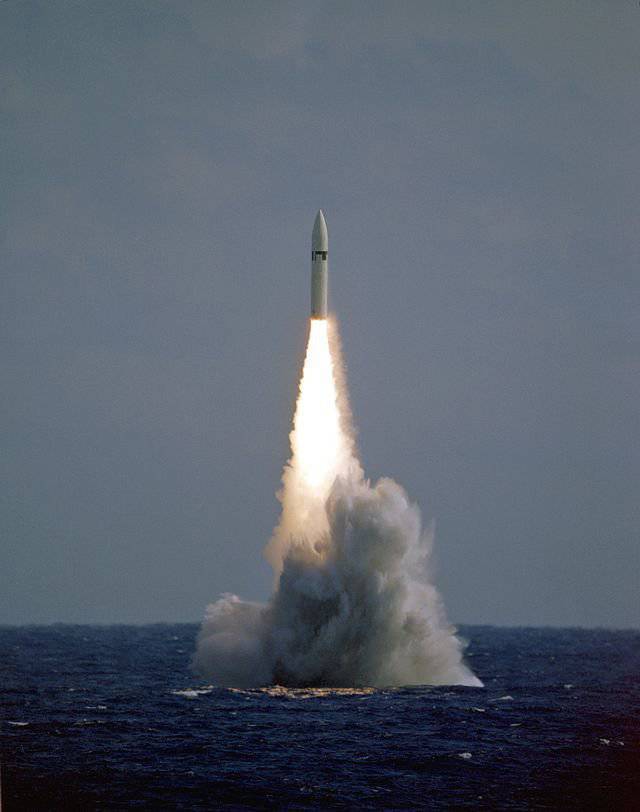
Launch of the UGM-27C Polaris A-3 from the USS Robert E. Lee nuclear submarine rocket carrier (SSBN-601)
November 20 1978 years
Considering these circumstances, in 1962, it was decided to start developing a new BR PCM-25 (this designation of this BR was adopted under the SALT agreements and we will continue to follow in the designations of all subsequent BRs in accordance with them). Despite the fact that all US marine BRs were two-step, the PCM-25, like its predecessors, was single-stage. Fundamentally new for this BR was the factory refueling of the rocket with long-lasting fuel components followed by ampulization. This made it possible to remove the problem of servicing these BRs during their long-term storage. After that, the simplicity of servicing a BR with a LRE equaled that of a BR with a solid propellant rocket motor. In terms of firing range, it was still inferior to the BR "Polaris A2" (since it was one-step). The first modification of this missile was put into service in 1968. In 1973, it was upgraded to increase the firing range, and in 1974, it was equipped with a three-unit split head-type cassette (MFR CT).
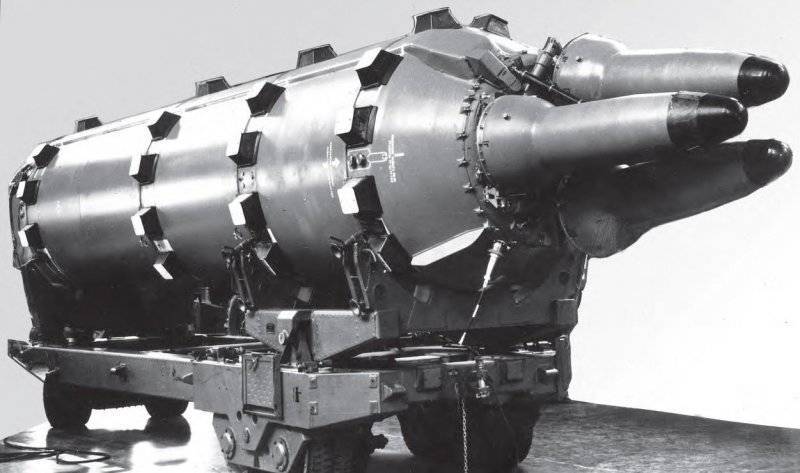
Rocket R-27 index of the URAV Navy - 4K10 code START - RSM-25 code of the US Ministry of Defense and NATO - SS-N-6 Mod 1, Serb
The increase in the firing range of domestic SSBNs was due to the objective desire to remove the areas of their combat patrols from the zone of the greatest activity of the anti-submarine forces of the likely enemy. This could be achieved only by creating a maritime intercontinental BR (ICBM). Task for the development of ICBMs PCM-40 was issued in 1964 year.

Sea ballistic missile P-29 (PCM-40) (SS-N-8)
Using a two-stage scheme, it was possible for the first time in the world to create a naval ICBM with a firing range of almost 8 km, which was more than that of the ICBMs then being developed in the United States. Trident 1 ("Trident-1")... Astro correction was also used for the first time in the world to improve the accuracy of shooting. This ICBM was put into service in 1974. The RSM-40 ICBM was constantly modified in the direction of increasing the firing range (up to 9 100 km) and the use of MIRVs.

Intercontinental ballistic missile with a single-piece head (P-29)
1. Instrument compartment with engine case removal. 2. Warhead. 3. Second stage fuel tank with hull oxidation engines. 5. Second stage engines. 6. Tank oxidizer first stage. 7. First stage fuel tank. 8. The guide bow. 9. Engine first stage. 10. Adapter. 11. Dividing bottom
The latest modifications of this MBR (1977 year) were so qualitatively different from the first samples that they received a new designation according to WWS. PCM-50. Finally, it was this ICBM for the first time in the Navy of the USSR that it began to be equipped with individual targeting MSCVs (MILVA IN), which characterized a new stage in the development of this type weapons.
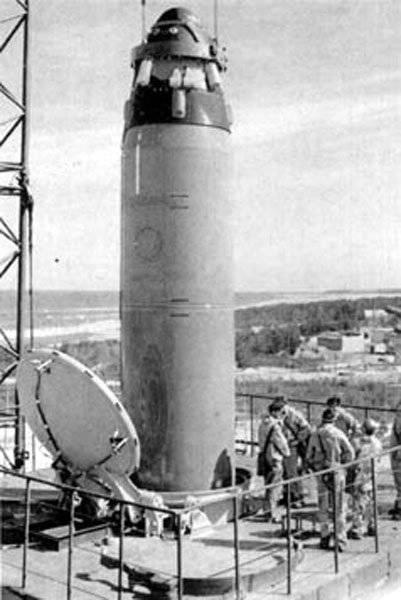
P-29 rocket loading (PCM-50)
At the first stage of the development of marine BR (from 1955 year to 1977 year), they were intended to defeat large area targets. Improving the accuracy of shooting only reduced the minimum size of the areal target and, therefore, expanded the possible number of targets fired. Only after the introduction of the RGCH IN into the 1977, did it become possible to strike at pinpoints. Moreover, the accuracy of striking an ICBM with an ICHM IN was almost equal to the accuracy of striking a nuclear weapon by strategic bombers.
At last, the last ICBM with the liquid-propellant rocket engine of the Soviet Navy - PCM-54 was put into service in 1986. This three-stage ICBM with a launch weight of about 40 tons had a firing range of more than 8 km and carried 300 MIRVs.
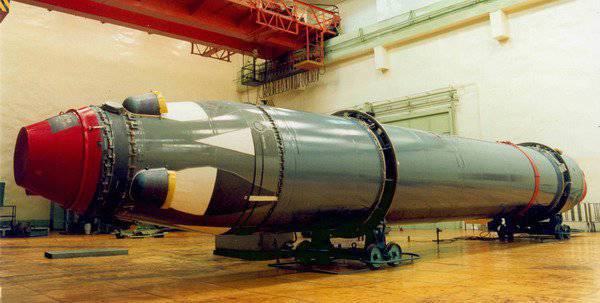
R-29RMU2 RSM-54 "Sineva" - ballistic missile submarine 667BDRM
Accuracy has doubled compared to the PCM-50. This was achieved through a dramatic improvement in the individual guidance (IN) system of the combat unit.
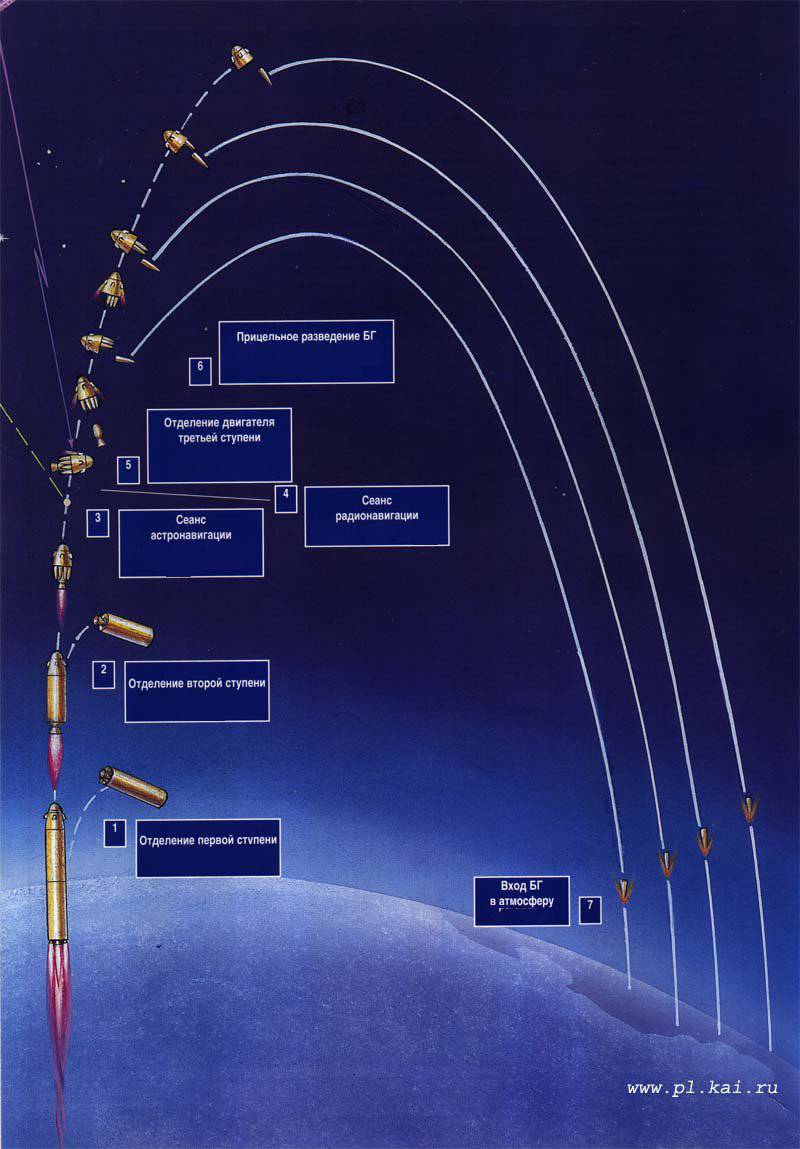
RSM-54 rocket flight path
Work on the creation of BR with a solid propellant was conducted by the USSR back in 1958-64. Studies have shown that for marine BRs this type of engine does not offer any advantages, especially after applying ampulization of charged fuel components. Therefore, in the office of V.P.Makeev, they continued to work on BR with LRE, but theoretical and experimental design work on BR with RDTT was also conducted. The chief designer himself, not without reason, believed that in the foreseeable future technological advances would not be able to provide the advantages of these missiles over the BR with the LRE.
VPMakeev also believed that in the development of marine BRs it is impossible to “shy away” from one direction to another, wasting enormous funds on the results achievable by the simple development of the existing scientific and technical potential. However, at the end of the 60-s and the beginning of the 70-s for the Strategic Missile Forces began to create ICBMs with RTDT (PC-12 - 1968, PC-14 - 1976, RSD-10 - 1977 g.). Based on these results, strong pressure from Marshal was organized on V.P.Makeyev. D.F.Ustinova in order to force him to develop an ICBM with a solid propellant. In an atmosphere of nuclear-rocket euphoria, the objections of the economic plan were not perceived at all ("how much money we need, we will give so much") The solid-propellant rocket missiles then had a much shorter shelf life compared to rockets with liquid propellant rocket engines due to the rapid decomposition of the components of solid fuel. Nevertheless, the first marine BR with solid propellant rotors was created in 1976. Its tests were carried out on SSBNs Ave. 667АМ. However, it was adopted only in 1980 year and did not receive further development.
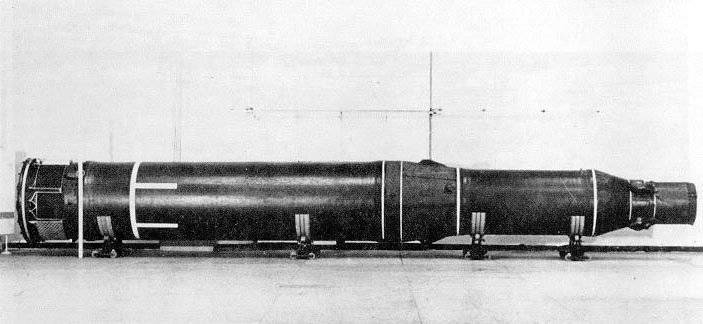
Medium-range rocket 15Ж45 of the Pioneer RSD-10 complex (photo from the INF Treaty)
The experience gained has been used to create a marine ICBM. PCM-52 with 10 RGCH IN.
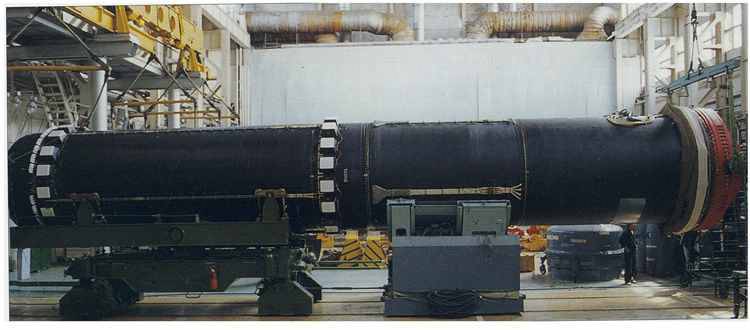
The PCM-52 missiles were equipped with nuclear warheads up to 100 kilotons. As part of the 12-year project, the 78 RSM-52 missiles were destroyed.
The resulting mass and size of this ICBM turned out to be such that the SALT contract saved the country from the ruinous large-scale deployment of them to SSBNs.
Summing up the development of naval missile complexes in the USSR Navy, I would like to note that, surpassing the mid-70-ies of the US ICBM in terms of firing range, they were inferior to them in accuracy and in the number of warheads. The link between the accuracy of the ICBM firing and the provisions of military doctrine was considered earlier, when considering SSBNs, here we will focus on technical aspects. It is known that the radius of destruction during an explosion (including nuclear) is proportional to the cubic root of the charge power. Therefore, to obtain the same probability of damage with worse accuracy, it is necessary to increase the power of a nuclear charge in proportion to the cube (if the accuracy is worse by 2 times, then the power of the nuclear charge must be increased by 8 times) or to abandon the defeat of such targets. Losing in the elemental base of control systems, domestic ICBMs not only had lower accuracy of fire, but also a smaller amount of HSR (each combat unit had to be equipped with a more powerful charge, and, consequently, its weight increased).
For this reason, it is groundless to blame the designers for various shortcomings of these weapons systems.
The main TTDs of naval armored personnel carriers that were in service with the USSR Navy are shown in the table.
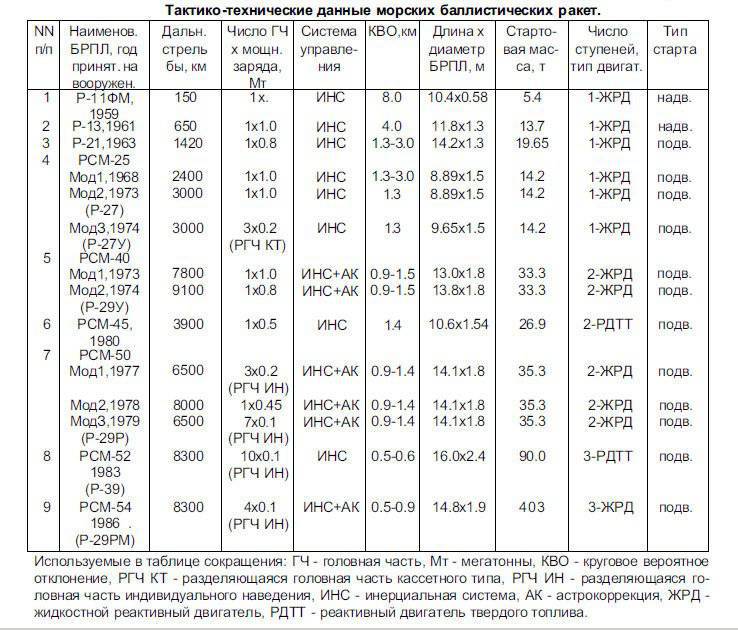
См. также The main stages of development of the marine strategic complexes of the USSR and the USA
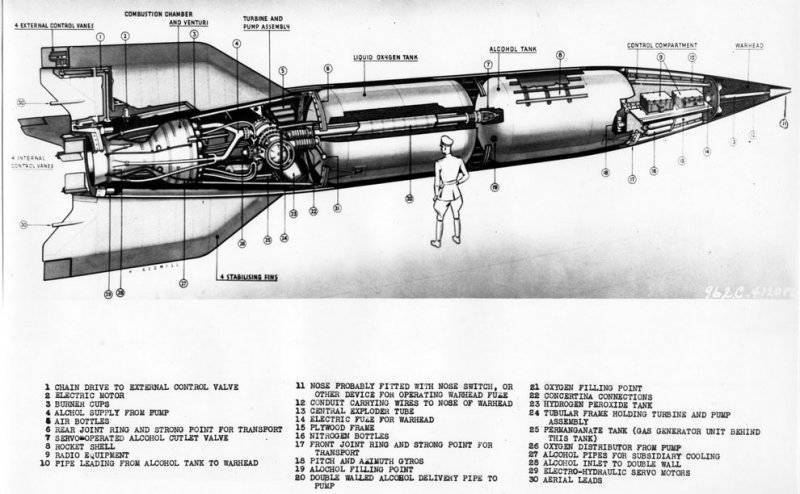
Information